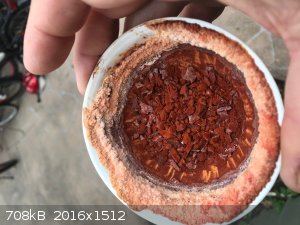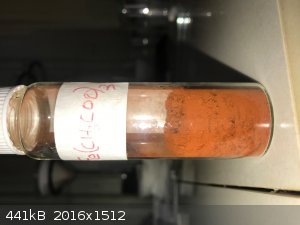mericad193724
Hazard to Others
  
Posts: 121
Registered: 4-6-2006
Location: New Jersey, USA
Member Is Offline
Mood: why do you care?
|
|
Iron Acetate
I am currently making Iron Acetate by putting steel wool (treated with acetone) into a 250ml flask and filling it with 5% Acidic acid. This should
make Iron Acetate over the course of a few days. (Source: website - Google iron acetate)
I don't know what the reaction would be...Can I put a stopper on the flask? Is gas being produced?
Fe + CH3COOH -> ???
thanks
Mericad
|
|
|
12AX7
Post Harlot
    
Posts: 4803
Registered: 8-3-2005
Location: oscillating
Member Is Offline
Mood: informative
|
|
"Acidic acid"? Just a little redundant, eh? Not too specific, unfortunately.
Did you mean "acetic"?
If so, the reaction will be:
Fe(s) + 2CH3COOH(aq) = Fe(2+)(aq) + 2CH3COO-(aq) + H2(g)
(Iron reduces the hydrogen clinging on the molecule, producing hydrogen gas.) (Ok, this equation isn't quite correct- the iron in solution is
probably combined with the acetate molecules by coordination.)
If the reaction proceeds slowly, it may be that oxygen (from air) is dissolving in the water, causing the iron to oxidize. The acetic acid then
removes the oxide as iron acetate.
I'll warn you, you may not be able to crystallize the product in any meaningful way. Once you remove the metal, oxygen may also kick it up to ferric,
Fe(3+), which is brown (I'm guessing ferrous acetate is green or something).
Ah, ferrous acetate forms a light green tetrahydrate (Wikipedia), but I can't find a damn thing on the ferric salt.
Tim
|
|
|
guy
National Hazard
   
Posts: 982
Registered: 14-4-2004
Location: California, USA
Member Is Offline
Mood: Catalytic!
|
|
The ferric salt is blood red. Complexes with the acetate ion.
|
|
|
Nerro
National Hazard
   
Posts: 596
Registered: 29-9-2004
Location: Netherlands
Member Is Offline
Mood: Whatever...
|
|
When you add iron wool to acetic acid (I used 80%) and add a small splash of H2O2 30% the reaction will be very fast and a very pretty solution of
Fe(Ac)3 (nett formula, I don't know how the complexing works) will be formed.
#261501 +(11351)- [X]
the \"bishop\" came to our church today
he was a fucken impostor
never once moved diagonally
courtesy of bash
|
|
|
mericad193724
Hazard to Others
  
Posts: 121
Registered: 4-6-2006
Location: New Jersey, USA
Member Is Offline
Mood: why do you care?
|
|
thanks guys...yes, I did mean "acetic" not acidic 
Mericad
|
|
|
pantone159
National Hazard
   
Posts: 586
Registered: 27-6-2006
Location: Austin, TX, USA
Member Is Online
Mood: desperate for shade
|
|
| Quote: | Originally posted by guy
The ferric salt is blood red. Complexes with the acetate ion. |
I just tried to make some of this, but without any luck.
I started with c. 3 mL of 3 M acetic acid, and added about a mL of 0.25 M ferric ammonium sulfate (in c. 2 M H2SO4), and hoped to see some red color,
but nothing.
Maybe I need higher concentrations? I can try Fe metal in 100% acetic acid if need be, but the above concentrations were what I had handy.
|
|
|
Nerro
National Hazard
   
Posts: 596
Registered: 29-9-2004
Location: Netherlands
Member Is Offline
Mood: Whatever...
|
|
Just put Fe in the HAc and let it stand for some time.
#261501 +(11351)- [X]
the \"bishop\" came to our church today
he was a fucken impostor
never once moved diagonally
courtesy of bash
|
|
|
mericad193724
Hazard to Others
  
Posts: 121
Registered: 4-6-2006
Location: New Jersey, USA
Member Is Offline
Mood: why do you care?
|
|
I let my acetic acid and Fe react over night. It became slightly murky, but still fairly clear. When added to 3% H2O2 it instantly turned blood red
(ferric), as 12AX7 said. When added to ammonia...instant Iron Hydroxide green jello! (Do not eat  ) )
Are there ANY soluble iron containing compounds that don't turn to ferric! I have tried everything!
Please help
Mericad
|
|
|
pantone159
National Hazard
   
Posts: 586
Registered: 27-6-2006
Location: Austin, TX, USA
Member Is Online
Mood: desperate for shade
|
|
I had better luck with my second try.
To c. 3 g of 3 mol/kg HOAc (acetic acid), I added c. 0.5-1.0 g of Fe powder, and a little bit of 3% H2O2.
Bubbling commenced (H2), and the solution soon became red-brown, presumably this complex. I wouldn't quite call it blood red, but it is kind of
close.
I wondered if this could really be a Fe(II) complex, since when Fe dissolves it does so first as Fe(II), which is then oxidized to Fe(III). So, I
tried a little bit of ferrous ammonium sulfate with some more HOAc, and some ferric ammonium sulfate. The ferrous mix formed a nearly colorless
solution, while the ferric mix was orange, darker than the usual color you see with Fe(III) solutions. (Tho the color isn't really from Fe(III).)
So it does seem to be ferric.
It also does seem to be harder to make than other complexes I have messed with. Usually, something like my first try, adding 0.25 mol/kg ferric ion
to something makes an obvious visual change, but with this one I saw nothing until using elemental Fe.
As far as ferrous salts that don't turn to ferric, I think ferrous ammonium sulfate is one of the best. It doesn't make stable solutions, however.
|
|
|
mericad193724
Hazard to Others
  
Posts: 121
Registered: 4-6-2006
Location: New Jersey, USA
Member Is Offline
Mood: why do you care?
|
|
Thanks for the ferrous salt pantone159, is there anything more stable? The msds says ferrous ammonium sulfate oxidizes in moist air.
Mericad
|
|
|
pantone159
National Hazard
   
Posts: 586
Registered: 27-6-2006
Location: Austin, TX, USA
Member Is Online
Mood: desperate for shade
|
|
| Quote: | Originally posted by mericad193724
Is there anything more stable? The msds says ferrous ammonium sulfate oxidizes in moist air.
|
Ferrous salts aren't all that stable, you'll need to keep the container well closed and away from that pesky moist air.
AFAIK, nothing is really more stable than the ferrous ammonium sulfate double salt.
For keeping ferrous solutions, having some iron metal in the bottle is supposed to help. My one try at this did not work, but I was using an
acidified solution which was possibly a no-no.
I've heard that bright sunlight is actually good for ferrous salts and solutions.
|
|
|
Lion850
National Hazard
   
Posts: 514
Registered: 7-10-2019
Location: Australia
Member Is Offline
Mood: Great
|
|
I thought making iron iii acetate (ferric acetate) by double displacement will be easy as it is insoluble in water. A very wrong assumption!
I mixed stoichiometric amounts of calcium acetate and ferric nitrate, each dissolved in a small amount of water. I almost immediately got a very dark
solution, almost black but brown-red in thin layers splashed up the side of the beaker. No ppt, not even after standing overnight. I then tried sodium
acetate and ferric nitrate, same result.
Reading up more then I gathered that there is quite a difference between basic ferric acetate (Fe3O(CH3COO)6(H2O)3 according to Wikipedia), which is
indeed insoluble in water, and 'normal' ferric acetate Fe(CH3COO)3.xH2O which is soluble in water.
Assuming that the double displacement method was making normal ferric acetate, I decided to use sodium acetate and ferric chloride as starting
materials, this should give me ferric acetate and sodium chloride both in solution, they would then be separated by dissolving the ferric acetate in
ethanol: references online say ferric acetate in soluble in ethanol (but I could not find a figure) while also saying sodium chloride is only very
slightly soluble in ethanol.
20g ferric chloride hexahydrate was reacted with 30g sodium acetate trihydrate, and I got the familiar dark solution with no ppt. This was then boiled
down on a steam back. A while salt, presumably the sodium chloride, crystallised out in a thick layer just below the rim of the crucible and a
brown-red salt in the bottom. See photo. There was occasionally a hint of vinegar smell, but very little. I was happy to see the salts apparently
separate quite well during the crystallising, and scraped out the section that visually appeared to have only the born-red salt and then the white-ish
crust into separate containers.
The brown-red presumably mostly ferric acetate was 11g, or 65% yield.
The white presumably sodium chloride was 11,3g, or about 80% yield.
I then scratched all the more mixed pieces into a beaker and added the white crust. Absolute ethanol was added and stirred for 30 minutes. After
stirring stopped a white layer settled in the bottom, with a thin brown layer on top, and dark brown supernatant solution. So it seemed to separate,
and that some ferric acetate dissolved in the ethanol, but it was also clear that at room temperature the solubility of the ferric acetate in ethanol
was not very high. I did not progress this as I did not want to use my precious 99% ethanol.
I wanted to make sure that the brown-red salt was not just iron oxide Fe2O3, as it is quite similar in appearance. I placed a small bit of each of the
presumed acetate and oxide in separate test tubes and shook with water. Both formed dark brown with a hint of red liquids. After 15 minutes standing
there was a hint that the test tube with the oxide was settling out, but it was a slow process. I then filtered the contents.
The presumed acetate solution ran through the filter paper maintaining its color and with near zero remainder. The oxide 'solution' was just a
suspension as it ran through clear and with the wet oxide left behind on the filter paper.
I also noticed when I cleaned the crucible and beaker that the brown-red salt very easily dissolved in hydrochloric acid giving a yellow solution
which is presumably ferric chloride.
Any thoughts on whether I really did end up with Fe(CH3COO)3 or what else it can be?
 
|
|
|